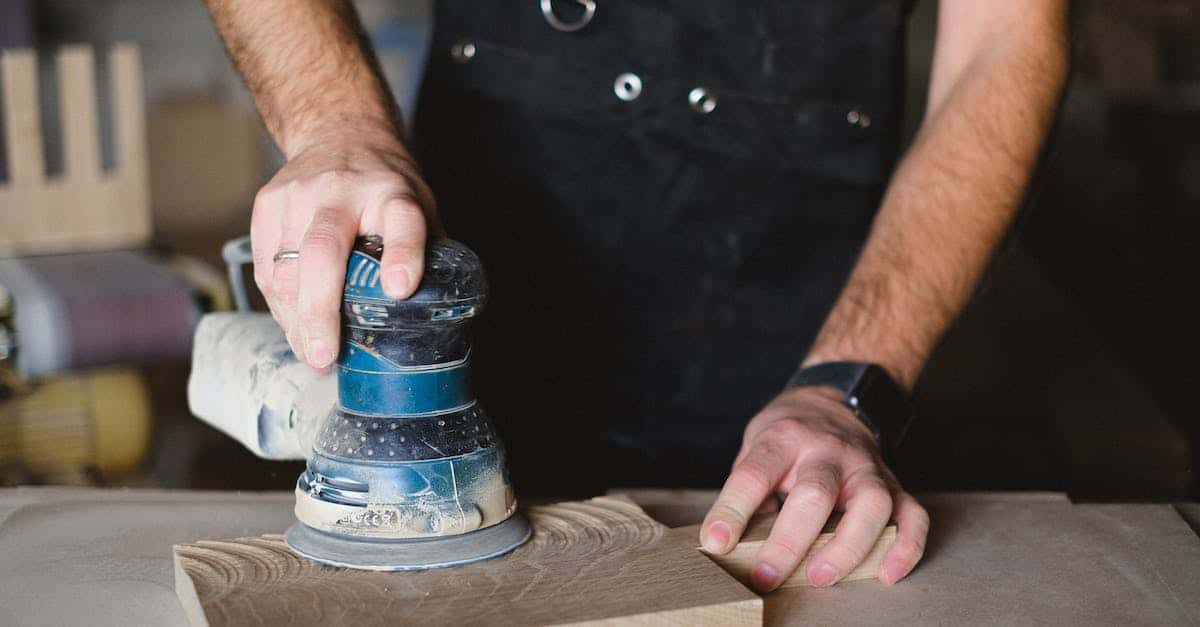Imagine channeling your creativity into woodworking, even if you have just one hand. It might seem challenging, but with the right techniques and tools, you can craft beautiful pieces that reflect your unique vision.
You’ll discover adaptable methods that make each step manageable, from measuring and cutting to assembling and finishing. Whether you’re a seasoned woodworker or just starting out, these strategies will empower you to take on projects with confidence.
Embrace the journey of one-handed woodworking and unlock your potential. With the right approach, your workshop can become a place of endless possibilities and rewarding accomplishments.
Adaptive Techniques
One-handed woodworking requires specific strategies to ensure precision and efficiency. By adopting these adaptive techniques, you can create high-quality projects with ease.
Modified Joinery Methods
Adapting joinery methods is essential for one-handed woodworking. Pocket hole joinery allows you to create strong connections without the need for complex setups. Dowel systems provide straightforward alignment, ensuring pieces fit together accurately. Biscuit joiners offer another reliable method for aligning and joining boards seamlessly. Using single-handed clamps helps secure your workpieces firmly, reducing movement during assembly. Additionally, automated fastening tools like screwdrivers with easy-grip handles simplify the fastening process, making joint creation more manageable.
Safety Considerations
Safety remains paramount when woodworking with one hand. Secure your workpiece using specialized clamps to prevent shifting during cuts or shaping. Ergonomic tool designs with comfortable grips enhance control and reduce fatigue, minimizing the risk of accidents. Personal protective equipment such as gloves and safety glasses protect against debris and tool mishaps. Implement blade guards and safety switches on power tools to provide an extra layer of protection. Regularly inspect and maintain your tools to ensure they operate safely and effectively, reducing the likelihood of unexpected failures.
Essential Tools
Having the right tools makes one-handed woodworking achievable and enjoyable. Equip your workshop with these essential tools tailored for single-handed use.
One-Handed Hand Tools
Select ergonomically designed saws, chisels, and planes that offer secure grips. For example, handle-less chisels allow precise control, while slip-resistant planes enhance safety. Ensure each tool balances well in your hand to reduce fatigue during extended projects.
Power Tool Adaptations
Utilize power tools with single-handed operation features, such as push-button triggers and easy-access switches. Equipment like cordless drills with side grips provide better maneuverability. Implement jigs and mounts to stabilize tools, ensuring accurate cuts and consistent results without requiring two hands.
Project Ideas
Explore a variety of woodworking projects tailored for one-handed construction. These ideas range from simple builds to more complex creations, allowing you to enhance your skills progressively.
Beginner Projects
- Picture Frames: Assemble and finish frames using pocket hole joinery for easy alignment and strong connections.
- Simple Shelves: Construct wall-mounted shelves with pre-cut boards and single-handed clamps for stability during assembly.
- Cutting Boards: Create durable cutting boards by gluing together hardwood strips and sanding them smooth for a finished look.
- Birdhouses: Build basic birdhouses using dowel systems for joining sides, roofs, and bases securely.
- Tool Holders: Design and fabricate customized tool holders to organize your workshop efficiently.
Advanced Projects
- Dining Tables: Craft large dining tables with intricate joinery techniques and reinforced supports for added strength.
- Cabinets: Build multi-door cabinets featuring adjustable shelves and precise alignments using biscuit joiners.
- Chests of Drawers: Assemble chests with multiple drawers, utilizing automated fastening tools for consistent and accurate construction.
- Outdoor Furniture: Create weather-resistant outdoor furniture pieces, incorporating ergonomic designs and secure fastening methods.
- Custom Woodwork Art: Design and produce intricate wood art installations, employing advanced carving tools and stabilization jigs for detailed work.
Resources and Support
Finding the right resources and support can make one-handed woodworking more accessible and enjoyable. Here are key resources to help you get started:
Online Communities and Forums
Join dedicated online communities where you can connect with other one-handed woodworkers. Websites like One Handed Woodworking and forums on Reddit offer advice, project ideas, and support from experienced members.
Adaptive Tool Suppliers
Access tools specifically designed for one-handed use from suppliers such as EasyWood Tools and OneHanded Solutions. These suppliers provide equipment like single-handed clamps, ergonomic saws, and modified power tools to enhance your woodworking experience.
Instructional Materials and Tutorials
Utilize instructional books and online tutorials tailored for one-handed woodworking. Resources like “One-Handed Woodworking Techniques” by John Doe and video tutorials on YouTube offer step-by-step guidance and project demonstrations to build your skills.
Local Organizations and Support Groups
Connect with local organizations that support individuals with disabilities in woodworking. Groups like Handiwood offer workshops, mentorship programs, and community events to help you network and learn from others.
Accessibility Grants and Funding Options
Explore grants and funding options to support your woodworking projects. Organizations such as Arts Access and Adaptive Woodworking Grants provide financial assistance to acquire adaptive tools and materials needed for your crafts.
Specialized Workshops and Classes
Enroll in specialized workshops and classes designed for one-handed woodworkers. Institutions like Local Community Colleges and Craft Centers offer courses that focus on adaptive techniques and safe woodworking practices.
Supportive Technology and Software
Leverage supportive technology to streamline your woodworking process. Software like SketchUp helps design projects, while assistive devices such as Voice-Controlled Tools allow for hands-free operation, enhancing precision and efficiency.
Mentorship Programs
Seek mentorship from experienced one-handed woodworkers through programs like Woodcraft Mentors. Mentors can provide personalized advice, share best practices, and help you overcome challenges in your woodworking journey.
By utilizing these resources and support systems, you can enhance your one-handed woodworking skills and enjoy creating beautiful wood projects with confidence.
Conclusion
Embracing one-handed woodworking opens up a world of creativity and satisfaction. With the right tools and techniques you can tackle projects that showcase your skills and ingenuity. Every cut and join shows your determination and passion. Grab your favorite tools and start building something amazing today. Your woodworking journey is just beginning and the possibilities are endless.
Frequently Asked Questions
Is woodworking possible for individuals with one hand?
Yes, woodworking is entirely possible for individuals with one hand. With the right adaptive techniques, tools, and modifications, one-handed woodworking can be a fulfilling and creative endeavor. Many accessible methods simplify the process, making it suitable for both beginners and experienced woodworkers.
What adaptive techniques are essential for one-handed woodworking?
Essential adaptive techniques include modified joinery methods like pocket hole joinery, dowel systems, and biscuit joiners. These techniques facilitate strong connections and accurate alignments. Additionally, using single-handed clamps and automated fastening tools enhances efficiency and ease of use during the woodworking process.
What safety measures should one-handed woodworkers take?
Safety is paramount in one-handed woodworking. It’s important to secure workpieces firmly, use ergonomic tools to reduce strain, and always wear personal protective equipment such as gloves and goggles. Regular tool maintenance ensures tools operate safely and effectively, minimizing the risk of accidents.
What tools are recommended for one-handed woodworking?
Recommended tools include ergonomically designed hand tools like saws, chisels, and planes with secure grips to reduce fatigue. Power tools with single-handed operation features, such as push-button triggers and cordless drills with side grips, are ideal. Additionally, jigs and mounts can stabilize tools for more accurate cuts.
Can beginners start one-handed woodworking?
Absolutely. There are numerous beginner-friendly projects like assembling picture frames, constructing simple shelves, creating cutting boards, building birdhouses, and designing tool holders. These projects allow beginners to gradually build their skills and gain confidence in one-handed woodworking.
What are some advanced woodworking projects for one-handed woodworkers?
Advanced projects include crafting dining tables, building cabinets, assembling chests of drawers, creating outdoor furniture, and producing custom woodwork art. These projects provide opportunities to enhance skills further while enjoying the creative and rewarding aspects of woodworking.
Where can one find resources and support for one-handed woodworking?
Resources and support can be found through online communities and forums, adaptive tool suppliers, and instructional materials tailored for one-handed woodworking. Local organizations, support groups, accessibility grants, specialized workshops, and mentorship programs also offer valuable assistance and networking opportunities.
Are there specific power tool adaptations for one-handed use?
Yes, there are power tool adaptations designed for one-handed use. Tools with push-button triggers, cordless drills with side grips, and jigs or mounts to stabilize tools are ideal. These adaptations make power tools easier to handle and operate safely with one hand, ensuring precise and efficient woodworking.
How important is tool maintenance in one-handed woodworking?
Tool maintenance is crucial in one-handed woodworking. Well-maintained tools operate more safely and effectively, reducing the risk of accidents and ensuring accurate work. Regular cleaning, sharpening, and checking for wear and tear help maintain the performance and longevity of woodworking tools.
Can technology assist in one-handed woodworking?
Yes, technology can greatly assist in one-handed woodworking. Supportive technology and software streamline the woodworking process, allowing for precise measurements, design planning, and tool stabilization. These advancements enable individuals to create beautiful wood projects with greater confidence and ease.




